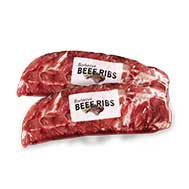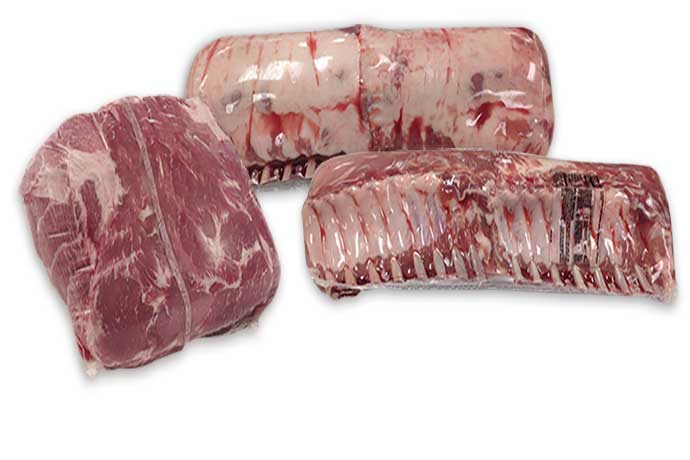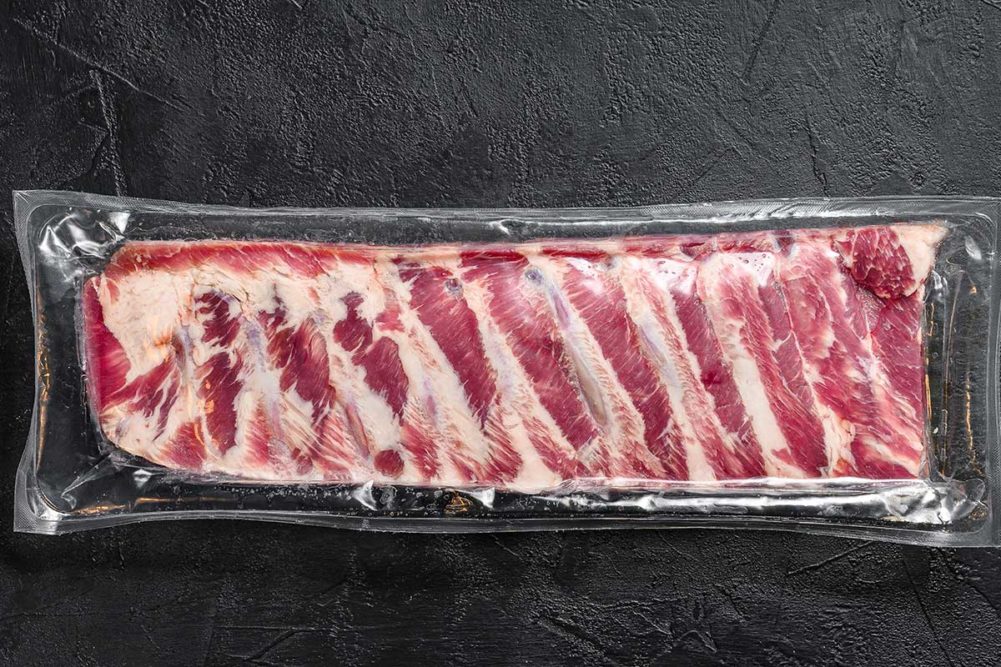Traditionally, when a bone-in cut of meat is purchased at a meat counter, it is wrapped in thick, but not impenetrable, butcher paper. Yet, that ubiquitous paper package can leave consumers with leaking bundles that are not sanitary or easy to store or freeze for later use.
From a marketing perspective, bone-in meat and poultry from self-serve, cold cases need to attractively represent the products to consumers without the risk of puncture or opening.
The 2020 Power of Meat report highlighted that “the continued growth of online purchases may require packaging innovations aimed at optimal shipping properties to minimize product damage.”
Bone-in meat products can be especially difficult to package because the pointed edges of the bones often puncture plastic and paper barrier packaging. Using thicker gauge plastics as a solution can make plastic packaging opaque and hard for consumers to see the meat or poultry they are choosing to purchase.
Packaging companies are innovating by using stronger plastics that still allow consumers to view the product clearly while relying on tighter seals that keep the integrity of the packaging, so products don’t leak and stay fresh longer. Packaging companies are making products and equipment that bring efficiency from the packing lines to the grocery store.
On the lookout for leaks
 TC Transcontinental Packaging uses Clearshield bone-in shrink and tubestock bags that allow consumers to see what they’re buying.
TC Transcontinental Packaging uses Clearshield bone-in shrink and tubestock bags that allow consumers to see what they’re buying.One of the main aspects that consumers look for in meat packaging is that it is leakproof. This has led most meat packaging companies to rely heavily on bags that can be vacuum-sealed because they offer leakproof protection as well as “many other advantages such as freezer-readiness, avoiding freezer burn, and extended home refrigerator storage that could be touted along with cleanliness,” as stated in The Power of Meat.
Yet, to properly protect vacuum-sealed bone-in products, bags often need extra plastic bone-guards inserted to prevent pinhole punctures. These extra layers of plastic can impede the clarity and look of a bone-in meat product.
TC Transcontinental Packaging, with US operations based in Chicago, uses Clearshield bone-in shrink and tubestock bags. The bags offer clear plastics with a glossy finish that allows consumers to see what they are buying.
The patchless bag technology is thinner, said Rob Taylor, director of marketing – protein. “The thinner gauge of Clearshield also provides a significant and immediate sustainability benefit versus traditional patch bags, allowing our customers to make strides towards their sustainability targets while improving package performance and optics.”
Less plastic used is less plastic wasted, which can offer cost-reductions down the line. This translates also into packaging equipment where customizing the bag sizes can significantly bring down costs to packers.
Finding ways to use less layers of plastic to package and display meats while accommodating the variety of shapes, sizes and cuts that bone-in products come in makes customization a primary mechanism to efficiency.
“TC Transcontinental Packaging has introduced our TC AB490 Autobaggers to allow our customers to create their own Clearshield bags, on demand, to whatever length and quantity they need, directly on their packing lines,” Taylor said.
Solution focused
 Amcor’s shrink rollstock plastic is customizable to each product’s size and shape. Source: Amcor Flexibles of North America
Amcor’s shrink rollstock plastic is customizable to each product’s size and shape. Source: Amcor Flexibles of North AmericaAutomating the process of packaging bone-in cuts can reduce the human error of puncturing bags while increasing production speed and efficiency. The company’s TC AB490 autobagger equipment can also streamline labelling and date/time stamps onto products providing further efficiency of a bone-in meat packaging line.
Amcor Flexibles of North America offers what it calls “high abuse bone-in and boneless tubestock packaging” which also can be customized to different products.
“Tubestock maintains all the features of a traditional bag,” said Greta Shimon, marketing manager at Amcor. “It can be sized and sealed to fit every product at the touch of a button and can be used in both a customer’s warehouse or right on each production line.”
Amcor also offers a shrink rollstock plastic that is customizable to each product’s size and shape. Shrink rollstock has the ability to significantly reduce the amount of packaging needed for a meat product, while still offering the durable and flexible components necessary for bone in meat and poultry.
“Shrink rollstock can also answer sourcing and warehousing challenges by eliminating up to 90% of pre-made bag SKUs and the need to inventory multiple bag sizes and graphics for each product,” Shimon said.
Both types of Amcor packaging can be used in automated packaging lines which enables packers the flexibility and efficiency of running lines for longer.
Some companies are innovating the creation of the actual plastic compounds that make puncture-resistant films that remain visually transparent.
“If you have a puncture, it doesn’t really matter what else you have,” said Jeff Hopp, director of marketing food for Charter Next Generation (CNG). “The next most critical attribute is the barrier itself.”
CNG, based out of Milton, Wis., is one of the largest independently owned extruded film companies in the country.
“It’s very important that customers don’t see a cloudy looking film on the outside of the meat. The clarity and gloss helps give the product a premium look on the shelf,” Hopp said. “It’s all about resin, resin technologies and processing.”
CNG works with resin companies to source new types of resins that will impart the characteristics it is looking for to make new types of films. The company is continually experimenting with different resins to meet the film and plastic packaging needs of their customers.
The 2020 Power of Meat report stressed that for meat and poultry products “claims such as organic and sustainably-raised have been areas of robust growth for years.” Another way to cater to the conscious-minded consumer is to limit single-use plastic packaging and to “implement environmentally-friendly packaging and shipping materials for meat/poultry and minimize their carbon footprint.”
CNG’s GreenArrow platform is focused on sustainable films and products. GreenArrow is focused on the reduce, reuse and recycle framework of sustainability. For now, CNG is not offering a GreenArrow film specifically for bone in products but the company has several film developments underway that will be applicable to the bone-in packaging, Hopp said.
The company is downgauging bio-based or compostable resins to reduce the amount of waste or non-recyclable material used in their packaging.
“For reuse, we’re able to include PCR – post consumer recycled content,” Hopp said. “For recyclables, we’re creating films that are all polyethylene-based. So they’re recycle-ready and have labels that tell customers about how to recycle them.”
It always comes back to the formability and the barrier for these types of packages.
Consumers want to see a bone-in meat or poultry product before they buy it, but that will not puncture. Consumers want to bring their protein home without it leaking onto their other groceries and then store the meat in the refrigerator or freezer for later use.


